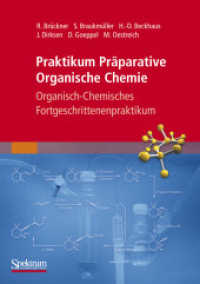- ホーム
- > 洋書
- > 英文書
- > Science / Mathematics
Full Description
Aerosol particles are ubiquitous in the Earth's atmosphere and are central to many environmental issues such as climate change, stratospheric ozone depletion and air quality. In urban environments, aerosol particles can affect human health through their inhalation.
Atmospheric aerosols originate from naturally occurring processes, such as volcanic emissions, sea spray and mineral dust emissions, or from anthropogenic activity such as industry and combustion processes. Aerosols present pathways for reactions, transport, and deposition that would not occur in the gas phase alone. Understanding the ways in which aerosols behave, evolve, and exert these effects requires knowledge of their formation and removal mechanism, transport processes, as well as their physical and chemical characteristics.
Motivated by climate change and adverse health effects of traffic-related air pollution, aerosol research has intensified over the past couple of decades, and recent scientific advances offer an improved understanding of the mechanisms and factors controlling the chemistry of atmospheric aerosols. Environmental Chemistry of Aerosols brings together the current state of knowledge of aerosol chemistry, with chapters written by international leaders in the field. It will serve as an authoritative and practical reference for scientists studying the Earth's atmosphere and as an educational and training resource for both postgraduate students and professional atmospheric scientists.
Contents
List of Contributors ix
Preface xi
1 Physical and Chemical Properties of Atmospheric Aerosols 1
Jay Turner and Ian Colbeck
1.1 Introduction 1
1.2 Ambient aerosol size distributions 3
1.2.1 Idealised size distributions of aerosol number and mass 3
1.2.2 Size distribution measurements 6
1.2.3 Dynamics of atmospheric aerosol size distributions 8
1.2.4 Features of selected ambient aerosol size distributions 11
1.3 Major chemical components of ambient fine particulate matter 15
1.4 Aerosol composition as a function of size 21
1.5 Summary and conclusions 22
References 25
2 Nucleation 31
Ari Laaksonen and Kari E.J. Lehtinen
2.1 Introduction 31
2.2 Nucleation kinetics 31
2.2.1 One-component systems 31
2.2.2 Binary systems 34
2.3 Nucleation thermodynamics 36
2.3.1 One-component systems 36
2.3.2 The classical theory 39
2.3.3 Multicomponent systems 40
2.4 The nucleation theorem 41
2.4.1 Scaling properties of critical clusters 42
2.4.2 An application to atmospheric nucleation 45
References 46
3 Mass Transfer to Aerosols 49
Charles F. Clement
3.1 Introduction 49
3.1.1 Equilibration between aerosol and gas 51
3.2 Transfer to a particle 52
3.2.1 Molecular motion 52
3.2.2 Motion in gases: kinetic theory 53
3.2.3 Diffusion 55
3.2.4 Diffusion to an aerosol particle 56
3.2.5 Combined diffusive and kinetic model 56
3.2.6 Fuchs mass transfer model 57
3.2.7 Heat and mass transfer 58
3.2.8 Multicomponent droplets and binary growth 64
3.2.9 Chemical model framework 65
3.2.10 Kinetic coefficients 67
3.3 Transfer to an aerosol 68
3.3.1 Aerosol description 68
3.3.2 Mean field approximation 70
3.3.3 Growth equations 73
3.3.4 Empirical atmospheric timescales 75
3.3.5 Redistributive processes 77
3.3.6 Nucleation mode mass transfer 79
3.3.7 Source terms 81
Appendix: water data 83
Nomenclature 83
References 85
4 Organic Aerosols 91
Mihalis Lazaridis
4.1 Introduction 91
4.2 Carbon-containing aerosols and their sources 93
4.2.1 Elemental carbon - primary organic carbon 93
4.2.2 Secondary organic matter formation (secondary organic carbon) 95
4.2.3 Biological aerosols 96
4.2.4 Biogenic aerosols 98
4.2.5 Modelling biogenic aerosol formation 99
4.2.6 Polycyclic aromatic hydrocarbons 100
4.2.7 Emission inventories of primary organic aerosols and gaseous precursors 102
4.3 Atmospheric chemistry of organic aerosols - field studies 102
4.3.1 Measurements of carbonaceous aerosols 102
4.3.2 Organic compounds - source apportionment 104
4.4 Carbonaceous aerosols at urban/rural environments 105
4.5 Summary 109
References 110
5 Metals in Aerosols 117
Irena Grgić
5.1 Introduction 117
5.2 Physico-chemical characteristics of metals in aerosols 118
5.2.1 Size distribution 118
5.2.2 Chemical speciation 122
5.3 Reactivity of transition metals 128
5.3.1 Photochemical/chemical cycling 128
5.3.2 Interactions of transition metals with S(IV) species 129
References 133
6 Thermodynamics of Aqueous Systems 141
David Topping
6.1 Introduction 141
6.2 Equilibrium 141
6.2.1 The chemical potential 143
6.2.2 Activity 145
6.3 Mixed solvent systems-a brief outline 147
6.4 Aqueous systems 148
6.4.1 Water content in the regime subsaturated with respect to water vapour 148
6.5 General aqueous thermodynamic equilibrium models for atmospheric aerosols 152
6.6 Inorganic systems 153
6.6 1 Activity coefficients 153
6.6.2 Bulk inorganic contributions to particulate water content in the regime subsaturated with respect to water vapour 155
6.7 Organic systems 157
6.7.1 Activity coefficients 157
6.7.2 Bulk organic contributions to particulate water content in the regime subsaturated with respect to water vapour 161
6.8 Mixed inorganic/organic systems 164
6.8.1 Activity coefficients - coupled thermodynamics 164
6.8.2 Activity coefficients - uncoupled thermodynamics 166
6.8.3 Bulk mixed inorganic/organic contributions to particulate water content in the regime subsaturated with respect to water vapour 166
6.8.4 Deliquescence 169
6.9 Temperature-dependent equilibrium 171
6.9 1 Deliquescence 171
6.9.2 Gas-to-particle partitioning 173
6.9.3 Activity 174
6.10 The influence of curvature 175
6.10.1 The Kelvin effect 175
6.10.2 The Köhler equation - describing the equilibrium between a curved particle and its humid environment: basic equilibrium considerations 177
References 181
7 Stratospheric Chemistry: Aerosols and the Ozone Layer 193
Rob MacKenzie
7.1 Introduction 193
7.2 General properties of the stratospheric aerosol layer 195
7.3 General stratospheric chemistry 197
7.3.1 Catalysed ozone loss 197
7.3.2 Initiation, null cycles, and termination of stratospheric chain reactions 199
7.4 Heterogeneous stratospheric chemistry 200
7.5 Polar stratospheric clouds and the 'ozone hole' 201
7.6 Volcanic aerosol 203
7.7 Meteoritic aerosol 207
7.8 Interactions between stratospheric chemistry and climate 208
References 210
8 Aerosol Chemistry in Remote Locations 217
Urs Baltensperger and Markus Furger
8.1 Introduction 217
8.1.1 Definition of 'remote locations' 217
8.1.2 Aerosol measurement and monitoring 219
8.1.3 Processes and mechanisms 220
8.2 Observations 224
8.2.1 Oceans and marine locations 225
8.2.2 Antarctica 228
8.2.3 Arctic 232
8.2.4 Tropical forests 235
8.2.5 Boreal forests 238
8.2.6 High elevation and free troposphere 239
8.3 Summary 242
References 244
Index 253
The colour plate section follows page 228








